MPE781 Economics Assignment: Tourism Investment Analysis 2018
VerifiedAdded on 2023/04/21
|19
|3765
|143
Homework Assignment
AI Summary
This economics assignment delves into the tourism investment landscape, primarily focusing on Australia. It analyzes the "Tourism Investment Monitor 2016-17" report by Tourism Research Australia (TRA), highlighting significant projects and investment values within the tourism sector. The assignment explores the microeconomic principles of demand and supply in relation to the hospitality industry, examining the impact of taxes on consumer and producer surplus in a perfectly competitive market. It further investigates the prudence of investment in the tourism sector, considering its contribution to Australia's GDP and the influence of foreign direct investment. The analysis includes statistical data, government policies, and comparisons with other countries like France, the United States, and Spain to provide a comprehensive understanding of tourism economics and investment strategies. The document is available on Desklib, a platform providing study tools for students.
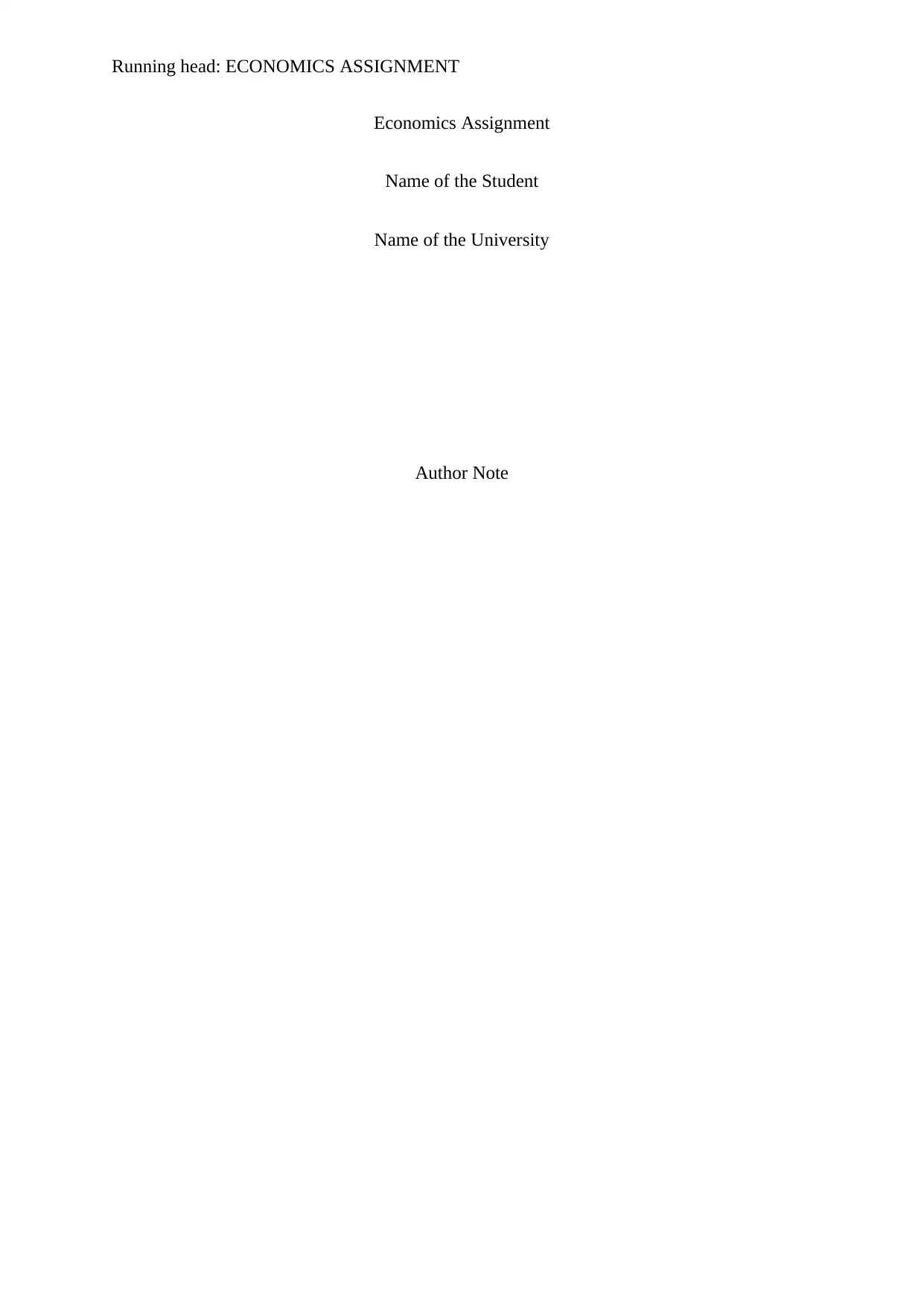
Running head: ECONOMICS ASSIGNMENT
Economics Assignment
Name of the Student
Name of the University
Author Note
Economics Assignment
Name of the Student
Name of the University
Author Note
Paraphrase This Document
Need a fresh take? Get an instant paraphrase of this document with our AI Paraphraser
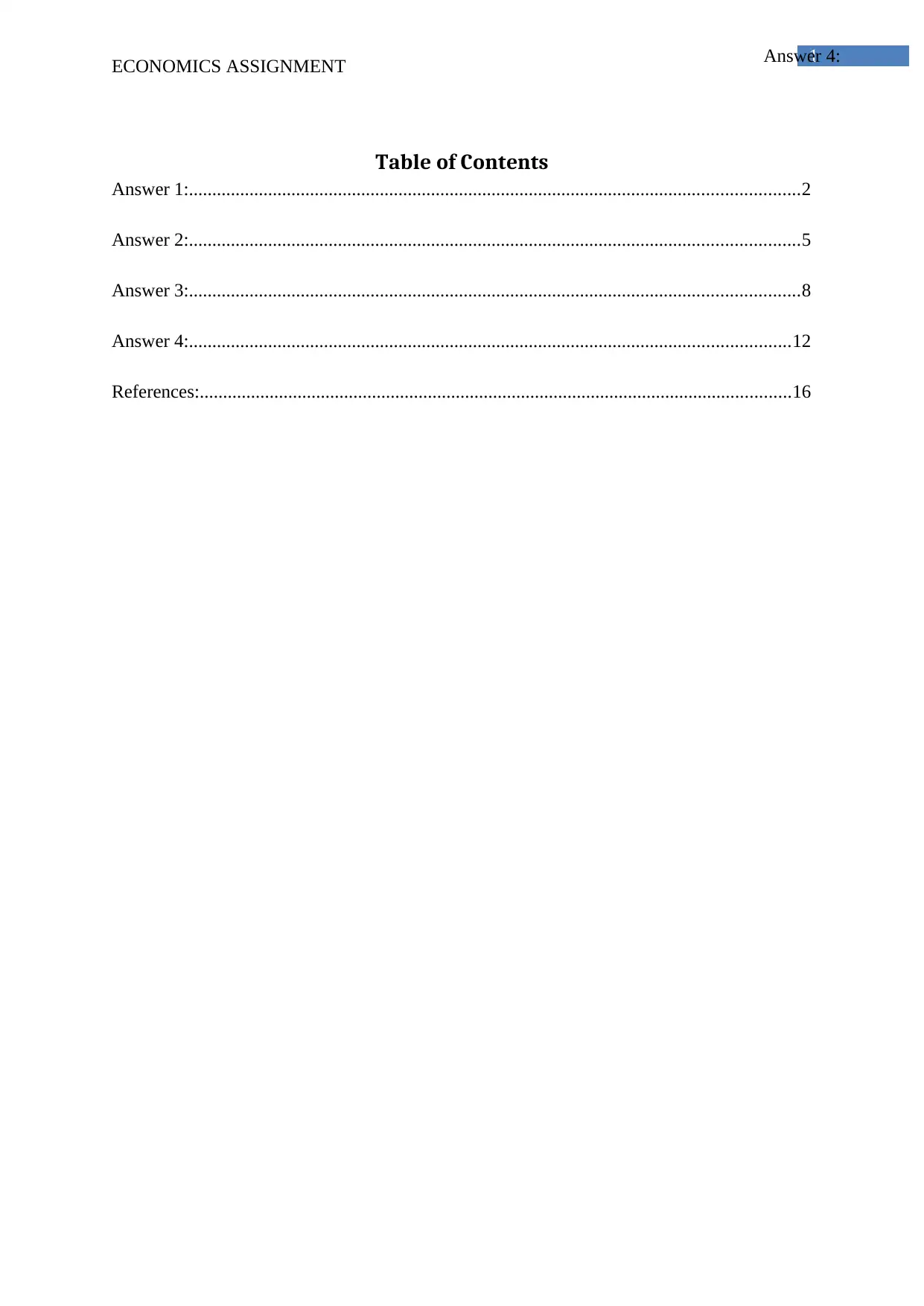
1Answer 4:
ECONOMICS ASSIGNMENT
Table of Contents
Answer 1:...................................................................................................................................2
Answer 2:...................................................................................................................................5
Answer 3:...................................................................................................................................8
Answer 4:.................................................................................................................................12
References:...............................................................................................................................16
ECONOMICS ASSIGNMENT
Table of Contents
Answer 1:...................................................................................................................................2
Answer 2:...................................................................................................................................5
Answer 3:...................................................................................................................................8
Answer 4:.................................................................................................................................12
References:...............................................................................................................................16
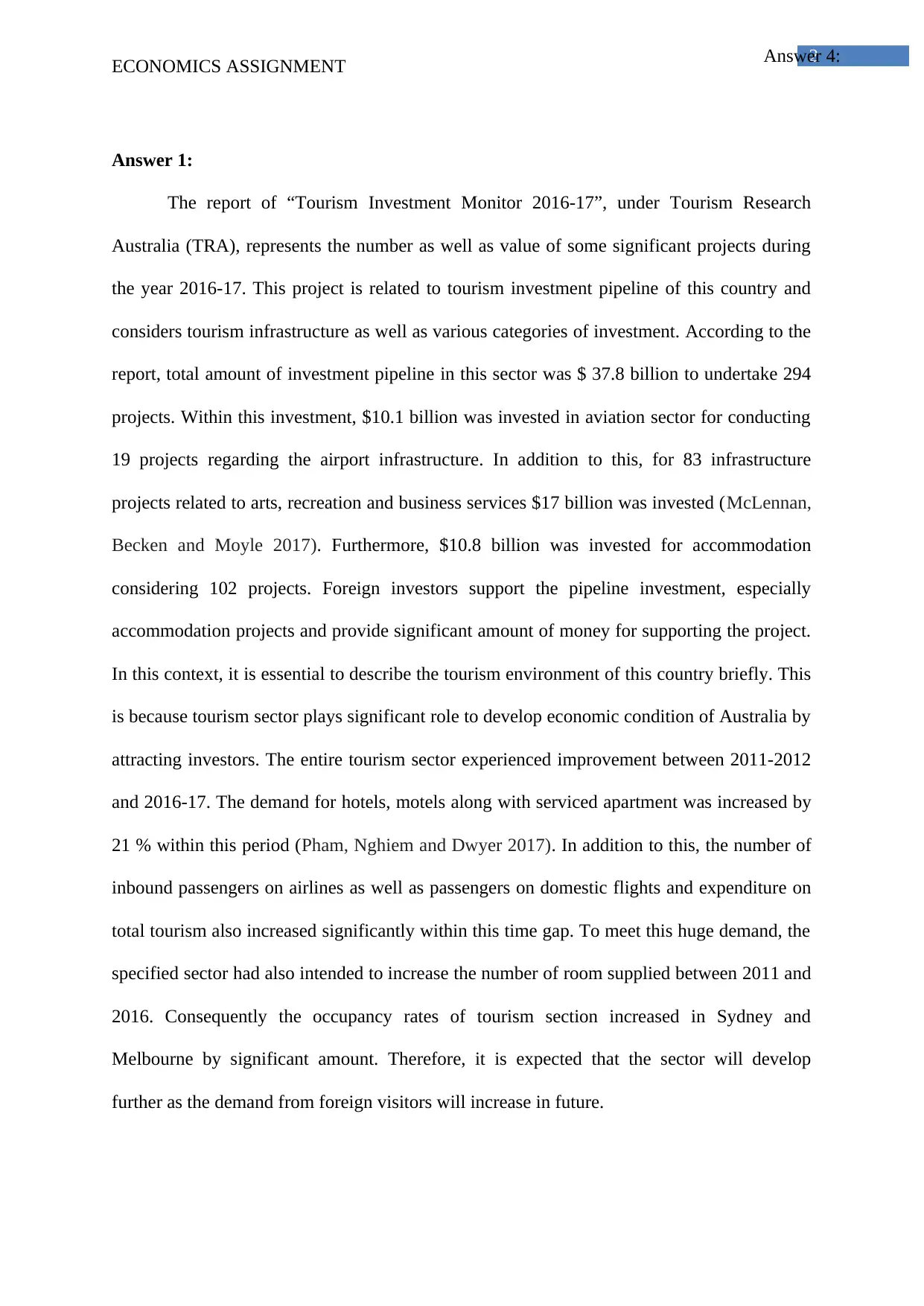
2Answer 4:
ECONOMICS ASSIGNMENT
Answer 1:
The report of “Tourism Investment Monitor 2016-17”, under Tourism Research
Australia (TRA), represents the number as well as value of some significant projects during
the year 2016-17. This project is related to tourism investment pipeline of this country and
considers tourism infrastructure as well as various categories of investment. According to the
report, total amount of investment pipeline in this sector was $ 37.8 billion to undertake 294
projects. Within this investment, $10.1 billion was invested in aviation sector for conducting
19 projects regarding the airport infrastructure. In addition to this, for 83 infrastructure
projects related to arts, recreation and business services $17 billion was invested (McLennan,
Becken and Moyle 2017). Furthermore, $10.8 billion was invested for accommodation
considering 102 projects. Foreign investors support the pipeline investment, especially
accommodation projects and provide significant amount of money for supporting the project.
In this context, it is essential to describe the tourism environment of this country briefly. This
is because tourism sector plays significant role to develop economic condition of Australia by
attracting investors. The entire tourism sector experienced improvement between 2011-2012
and 2016-17. The demand for hotels, motels along with serviced apartment was increased by
21 % within this period (Pham, Nghiem and Dwyer 2017). In addition to this, the number of
inbound passengers on airlines as well as passengers on domestic flights and expenditure on
total tourism also increased significantly within this time gap. To meet this huge demand, the
specified sector had also intended to increase the number of room supplied between 2011 and
2016. Consequently the occupancy rates of tourism section increased in Sydney and
Melbourne by significant amount. Therefore, it is expected that the sector will develop
further as the demand from foreign visitors will increase in future.
ECONOMICS ASSIGNMENT
Answer 1:
The report of “Tourism Investment Monitor 2016-17”, under Tourism Research
Australia (TRA), represents the number as well as value of some significant projects during
the year 2016-17. This project is related to tourism investment pipeline of this country and
considers tourism infrastructure as well as various categories of investment. According to the
report, total amount of investment pipeline in this sector was $ 37.8 billion to undertake 294
projects. Within this investment, $10.1 billion was invested in aviation sector for conducting
19 projects regarding the airport infrastructure. In addition to this, for 83 infrastructure
projects related to arts, recreation and business services $17 billion was invested (McLennan,
Becken and Moyle 2017). Furthermore, $10.8 billion was invested for accommodation
considering 102 projects. Foreign investors support the pipeline investment, especially
accommodation projects and provide significant amount of money for supporting the project.
In this context, it is essential to describe the tourism environment of this country briefly. This
is because tourism sector plays significant role to develop economic condition of Australia by
attracting investors. The entire tourism sector experienced improvement between 2011-2012
and 2016-17. The demand for hotels, motels along with serviced apartment was increased by
21 % within this period (Pham, Nghiem and Dwyer 2017). In addition to this, the number of
inbound passengers on airlines as well as passengers on domestic flights and expenditure on
total tourism also increased significantly within this time gap. To meet this huge demand, the
specified sector had also intended to increase the number of room supplied between 2011 and
2016. Consequently the occupancy rates of tourism section increased in Sydney and
Melbourne by significant amount. Therefore, it is expected that the sector will develop
further as the demand from foreign visitors will increase in future.
⊘ This is a preview!⊘
Do you want full access?
Subscribe today to unlock all pages.

Trusted by 1+ million students worldwide
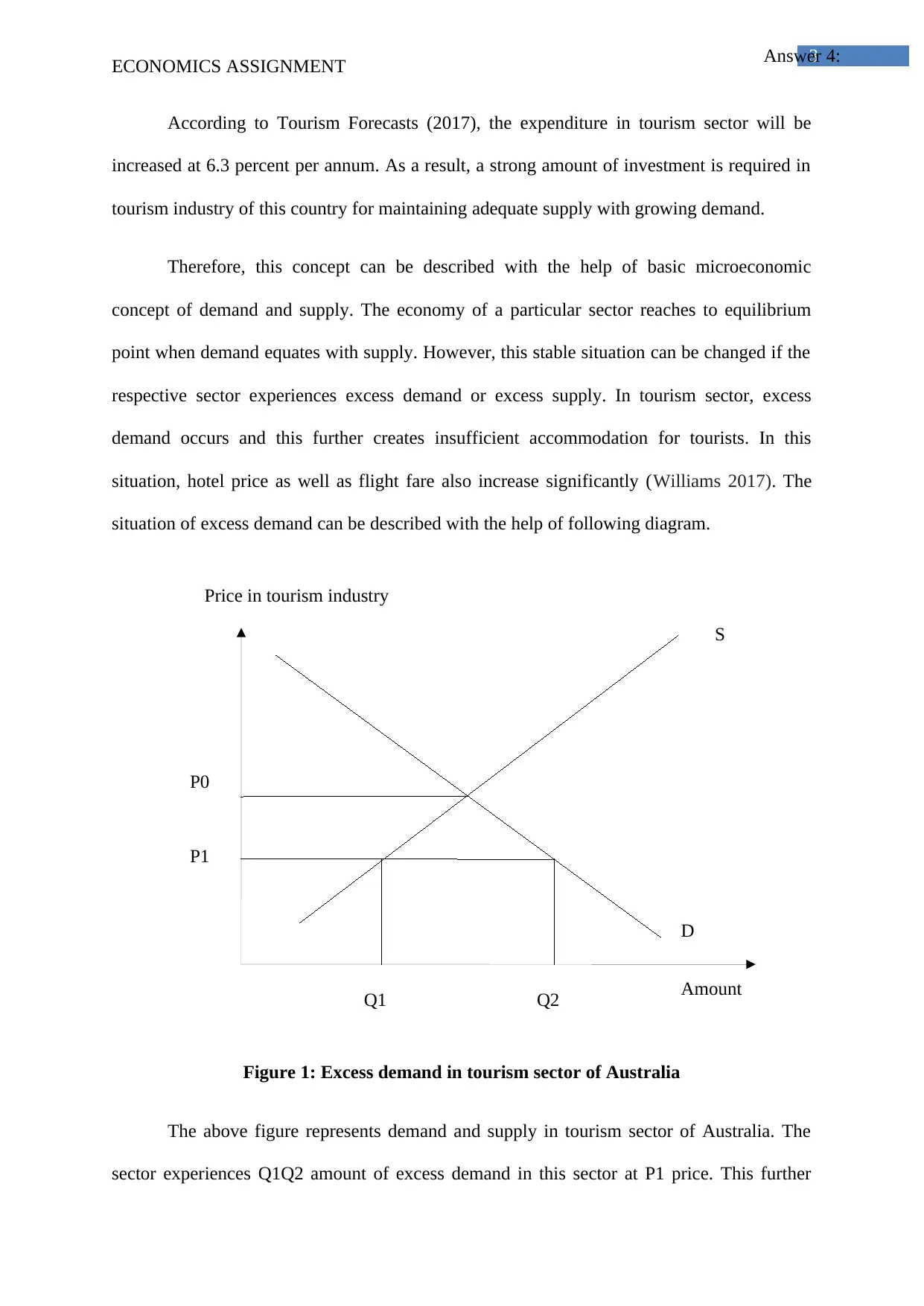
3Answer 4:
Price in tourism industry
Amount
S
D
P1
Q1 Q2
P0
ECONOMICS ASSIGNMENT
According to Tourism Forecasts (2017), the expenditure in tourism sector will be
increased at 6.3 percent per annum. As a result, a strong amount of investment is required in
tourism industry of this country for maintaining adequate supply with growing demand.
Therefore, this concept can be described with the help of basic microeconomic
concept of demand and supply. The economy of a particular sector reaches to equilibrium
point when demand equates with supply. However, this stable situation can be changed if the
respective sector experiences excess demand or excess supply. In tourism sector, excess
demand occurs and this further creates insufficient accommodation for tourists. In this
situation, hotel price as well as flight fare also increase significantly (Williams 2017). The
situation of excess demand can be described with the help of following diagram.
Figure 1: Excess demand in tourism sector of Australia
The above figure represents demand and supply in tourism sector of Australia. The
sector experiences Q1Q2 amount of excess demand in this sector at P1 price. This further
Price in tourism industry
Amount
S
D
P1
Q1 Q2
P0
ECONOMICS ASSIGNMENT
According to Tourism Forecasts (2017), the expenditure in tourism sector will be
increased at 6.3 percent per annum. As a result, a strong amount of investment is required in
tourism industry of this country for maintaining adequate supply with growing demand.
Therefore, this concept can be described with the help of basic microeconomic
concept of demand and supply. The economy of a particular sector reaches to equilibrium
point when demand equates with supply. However, this stable situation can be changed if the
respective sector experiences excess demand or excess supply. In tourism sector, excess
demand occurs and this further creates insufficient accommodation for tourists. In this
situation, hotel price as well as flight fare also increase significantly (Williams 2017). The
situation of excess demand can be described with the help of following diagram.
Figure 1: Excess demand in tourism sector of Australia
The above figure represents demand and supply in tourism sector of Australia. The
sector experiences Q1Q2 amount of excess demand in this sector at P1 price. This further
Paraphrase This Document
Need a fresh take? Get an instant paraphrase of this document with our AI Paraphraser
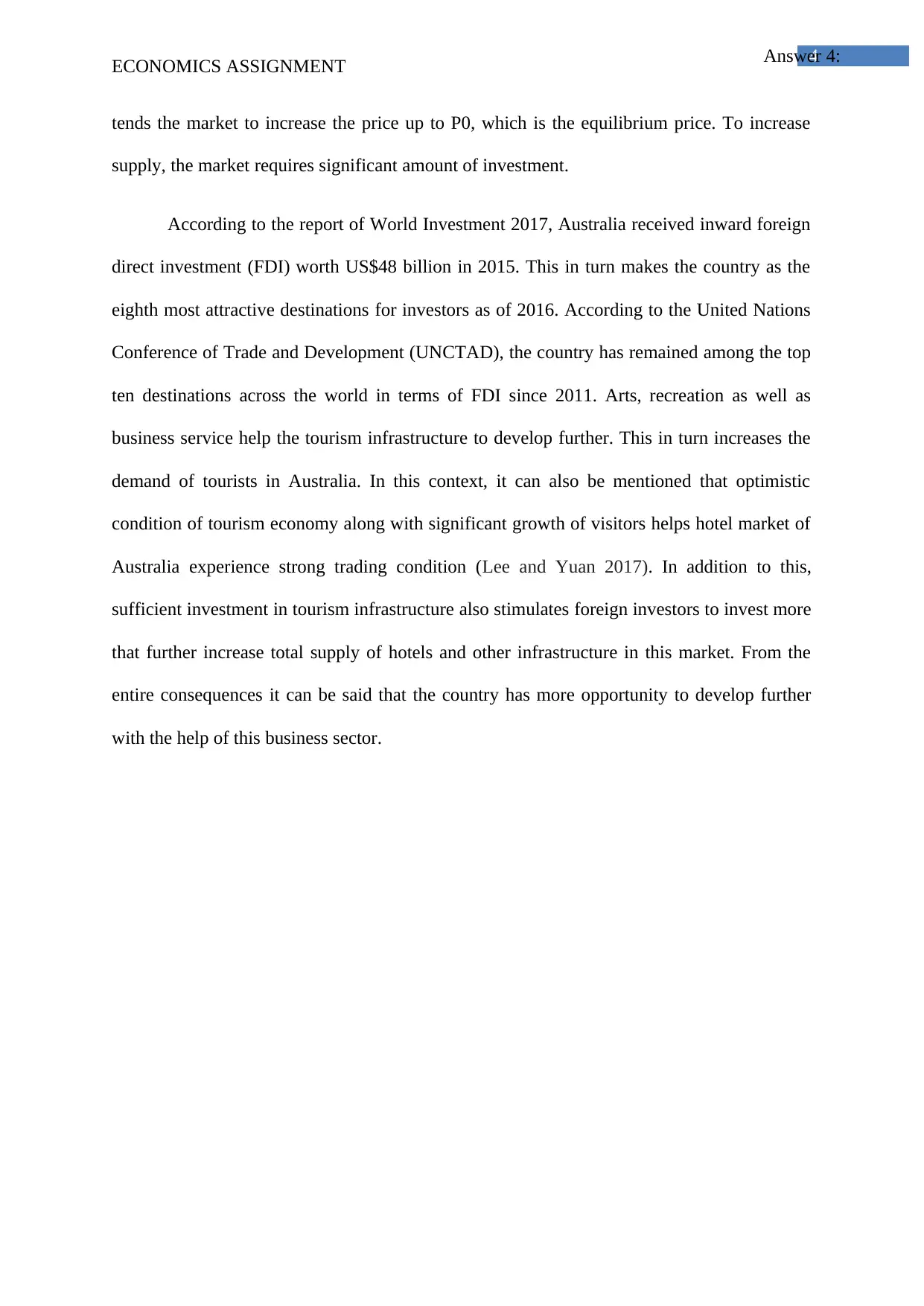
4Answer 4:
ECONOMICS ASSIGNMENT
tends the market to increase the price up to P0, which is the equilibrium price. To increase
supply, the market requires significant amount of investment.
According to the report of World Investment 2017, Australia received inward foreign
direct investment (FDI) worth US$48 billion in 2015. This in turn makes the country as the
eighth most attractive destinations for investors as of 2016. According to the United Nations
Conference of Trade and Development (UNCTAD), the country has remained among the top
ten destinations across the world in terms of FDI since 2011. Arts, recreation as well as
business service help the tourism infrastructure to develop further. This in turn increases the
demand of tourists in Australia. In this context, it can also be mentioned that optimistic
condition of tourism economy along with significant growth of visitors helps hotel market of
Australia experience strong trading condition (Lee and Yuan 2017). In addition to this,
sufficient investment in tourism infrastructure also stimulates foreign investors to invest more
that further increase total supply of hotels and other infrastructure in this market. From the
entire consequences it can be said that the country has more opportunity to develop further
with the help of this business sector.
ECONOMICS ASSIGNMENT
tends the market to increase the price up to P0, which is the equilibrium price. To increase
supply, the market requires significant amount of investment.
According to the report of World Investment 2017, Australia received inward foreign
direct investment (FDI) worth US$48 billion in 2015. This in turn makes the country as the
eighth most attractive destinations for investors as of 2016. According to the United Nations
Conference of Trade and Development (UNCTAD), the country has remained among the top
ten destinations across the world in terms of FDI since 2011. Arts, recreation as well as
business service help the tourism infrastructure to develop further. This in turn increases the
demand of tourists in Australia. In this context, it can also be mentioned that optimistic
condition of tourism economy along with significant growth of visitors helps hotel market of
Australia experience strong trading condition (Lee and Yuan 2017). In addition to this,
sufficient investment in tourism infrastructure also stimulates foreign investors to invest more
that further increase total supply of hotels and other infrastructure in this market. From the
entire consequences it can be said that the country has more opportunity to develop further
with the help of this business sector.
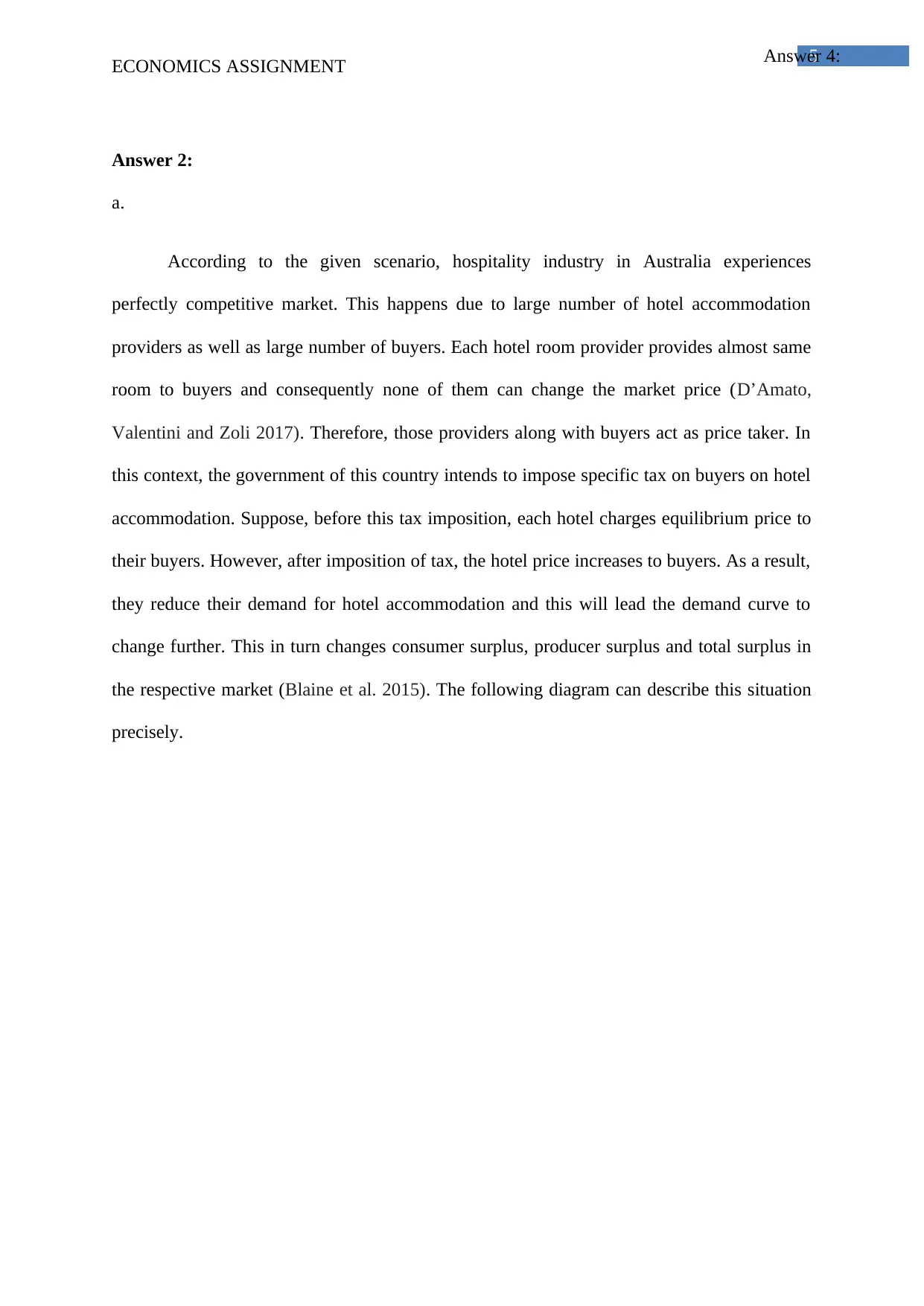
5Answer 4:
ECONOMICS ASSIGNMENT
Answer 2:
a.
According to the given scenario, hospitality industry in Australia experiences
perfectly competitive market. This happens due to large number of hotel accommodation
providers as well as large number of buyers. Each hotel room provider provides almost same
room to buyers and consequently none of them can change the market price (D’Amato,
Valentini and Zoli 2017). Therefore, those providers along with buyers act as price taker. In
this context, the government of this country intends to impose specific tax on buyers on hotel
accommodation. Suppose, before this tax imposition, each hotel charges equilibrium price to
their buyers. However, after imposition of tax, the hotel price increases to buyers. As a result,
they reduce their demand for hotel accommodation and this will lead the demand curve to
change further. This in turn changes consumer surplus, producer surplus and total surplus in
the respective market (Blaine et al. 2015). The following diagram can describe this situation
precisely.
ECONOMICS ASSIGNMENT
Answer 2:
a.
According to the given scenario, hospitality industry in Australia experiences
perfectly competitive market. This happens due to large number of hotel accommodation
providers as well as large number of buyers. Each hotel room provider provides almost same
room to buyers and consequently none of them can change the market price (D’Amato,
Valentini and Zoli 2017). Therefore, those providers along with buyers act as price taker. In
this context, the government of this country intends to impose specific tax on buyers on hotel
accommodation. Suppose, before this tax imposition, each hotel charges equilibrium price to
their buyers. However, after imposition of tax, the hotel price increases to buyers. As a result,
they reduce their demand for hotel accommodation and this will lead the demand curve to
change further. This in turn changes consumer surplus, producer surplus and total surplus in
the respective market (Blaine et al. 2015). The following diagram can describe this situation
precisely.
⊘ This is a preview!⊘
Do you want full access?
Subscribe today to unlock all pages.

Trusted by 1+ million students worldwide
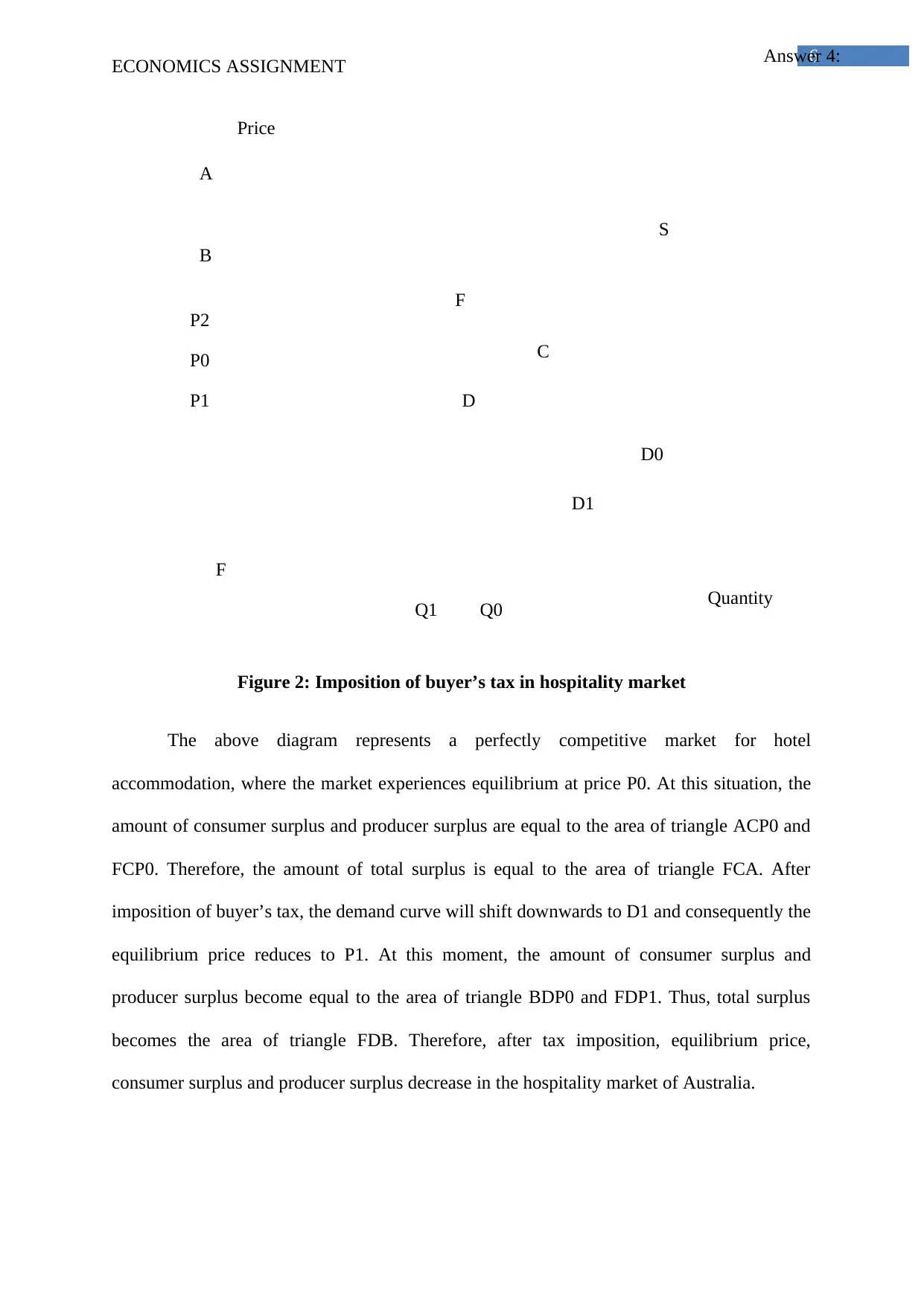
6Answer 4:
S
D0
D1
P0
P1
Q1 Q0
A
B
C
D
F
Price
Quantity
P2
F
ECONOMICS ASSIGNMENT
Figure 2: Imposition of buyer’s tax in hospitality market
The above diagram represents a perfectly competitive market for hotel
accommodation, where the market experiences equilibrium at price P0. At this situation, the
amount of consumer surplus and producer surplus are equal to the area of triangle ACP0 and
FCP0. Therefore, the amount of total surplus is equal to the area of triangle FCA. After
imposition of buyer’s tax, the demand curve will shift downwards to D1 and consequently the
equilibrium price reduces to P1. At this moment, the amount of consumer surplus and
producer surplus become equal to the area of triangle BDP0 and FDP1. Thus, total surplus
becomes the area of triangle FDB. Therefore, after tax imposition, equilibrium price,
consumer surplus and producer surplus decrease in the hospitality market of Australia.
S
D0
D1
P0
P1
Q1 Q0
A
B
C
D
F
Price
Quantity
P2
F
ECONOMICS ASSIGNMENT
Figure 2: Imposition of buyer’s tax in hospitality market
The above diagram represents a perfectly competitive market for hotel
accommodation, where the market experiences equilibrium at price P0. At this situation, the
amount of consumer surplus and producer surplus are equal to the area of triangle ACP0 and
FCP0. Therefore, the amount of total surplus is equal to the area of triangle FCA. After
imposition of buyer’s tax, the demand curve will shift downwards to D1 and consequently the
equilibrium price reduces to P1. At this moment, the amount of consumer surplus and
producer surplus become equal to the area of triangle BDP0 and FDP1. Thus, total surplus
becomes the area of triangle FDB. Therefore, after tax imposition, equilibrium price,
consumer surplus and producer surplus decrease in the hospitality market of Australia.
Paraphrase This Document
Need a fresh take? Get an instant paraphrase of this document with our AI Paraphraser
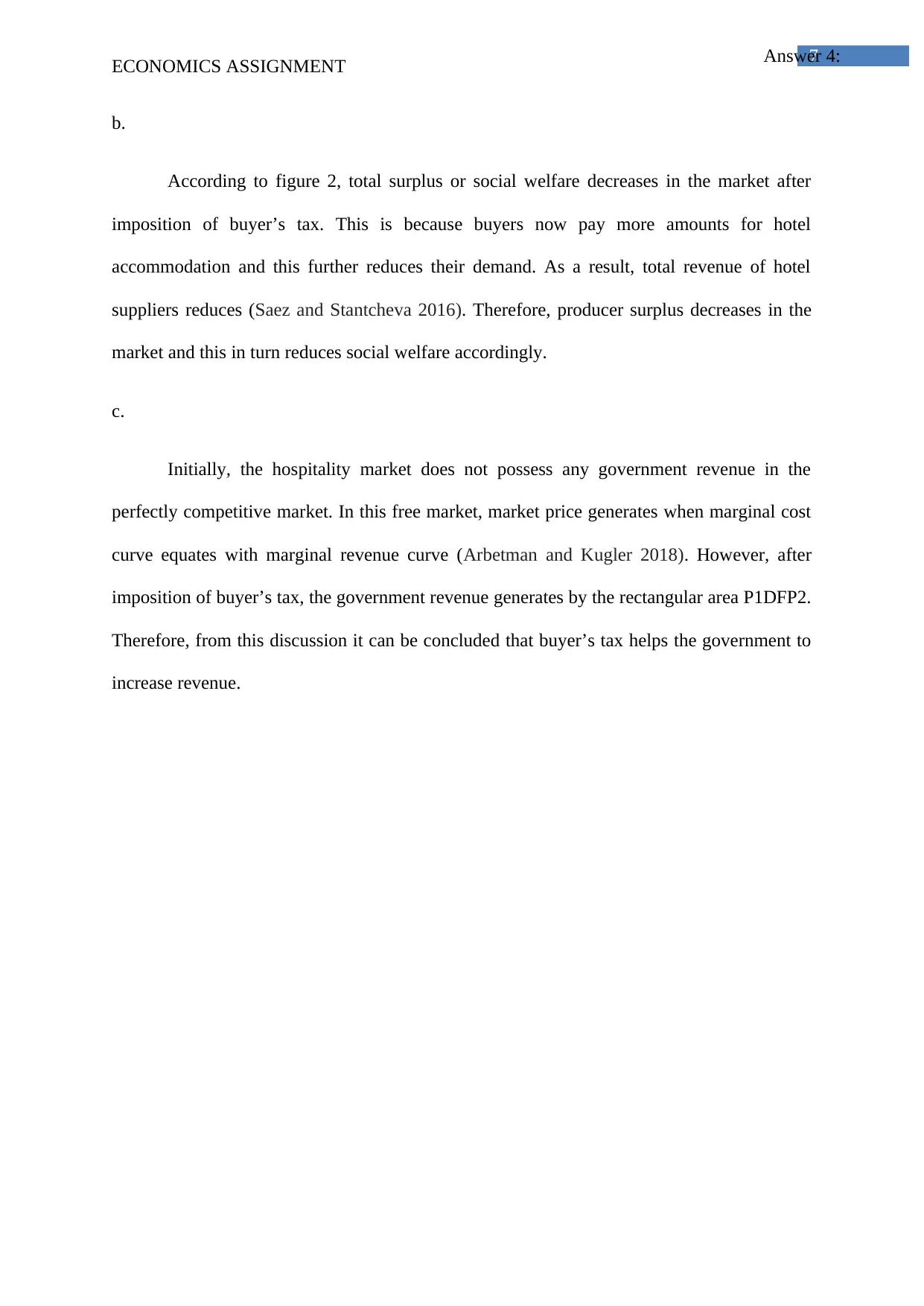
7Answer 4:
ECONOMICS ASSIGNMENT
b.
According to figure 2, total surplus or social welfare decreases in the market after
imposition of buyer’s tax. This is because buyers now pay more amounts for hotel
accommodation and this further reduces their demand. As a result, total revenue of hotel
suppliers reduces (Saez and Stantcheva 2016). Therefore, producer surplus decreases in the
market and this in turn reduces social welfare accordingly.
c.
Initially, the hospitality market does not possess any government revenue in the
perfectly competitive market. In this free market, market price generates when marginal cost
curve equates with marginal revenue curve (Arbetman and Kugler 2018). However, after
imposition of buyer’s tax, the government revenue generates by the rectangular area P1DFP2.
Therefore, from this discussion it can be concluded that buyer’s tax helps the government to
increase revenue.
ECONOMICS ASSIGNMENT
b.
According to figure 2, total surplus or social welfare decreases in the market after
imposition of buyer’s tax. This is because buyers now pay more amounts for hotel
accommodation and this further reduces their demand. As a result, total revenue of hotel
suppliers reduces (Saez and Stantcheva 2016). Therefore, producer surplus decreases in the
market and this in turn reduces social welfare accordingly.
c.
Initially, the hospitality market does not possess any government revenue in the
perfectly competitive market. In this free market, market price generates when marginal cost
curve equates with marginal revenue curve (Arbetman and Kugler 2018). However, after
imposition of buyer’s tax, the government revenue generates by the rectangular area P1DFP2.
Therefore, from this discussion it can be concluded that buyer’s tax helps the government to
increase revenue.
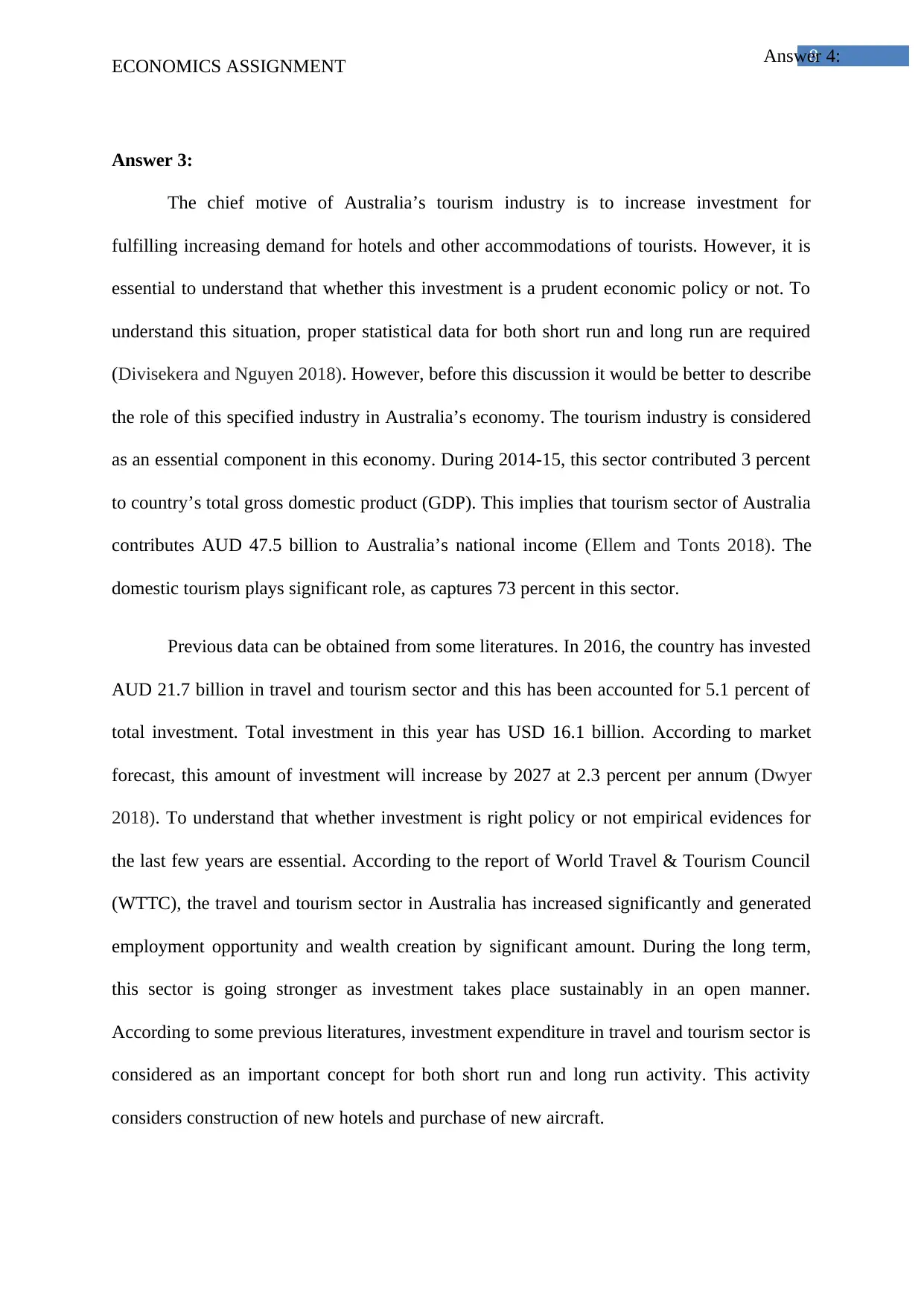
8Answer 4:
ECONOMICS ASSIGNMENT
Answer 3:
The chief motive of Australia’s tourism industry is to increase investment for
fulfilling increasing demand for hotels and other accommodations of tourists. However, it is
essential to understand that whether this investment is a prudent economic policy or not. To
understand this situation, proper statistical data for both short run and long run are required
(Divisekera and Nguyen 2018). However, before this discussion it would be better to describe
the role of this specified industry in Australia’s economy. The tourism industry is considered
as an essential component in this economy. During 2014-15, this sector contributed 3 percent
to country’s total gross domestic product (GDP). This implies that tourism sector of Australia
contributes AUD 47.5 billion to Australia’s national income (Ellem and Tonts 2018). The
domestic tourism plays significant role, as captures 73 percent in this sector.
Previous data can be obtained from some literatures. In 2016, the country has invested
AUD 21.7 billion in travel and tourism sector and this has been accounted for 5.1 percent of
total investment. Total investment in this year has USD 16.1 billion. According to market
forecast, this amount of investment will increase by 2027 at 2.3 percent per annum (Dwyer
2018). To understand that whether investment is right policy or not empirical evidences for
the last few years are essential. According to the report of World Travel & Tourism Council
(WTTC), the travel and tourism sector in Australia has increased significantly and generated
employment opportunity and wealth creation by significant amount. During the long term,
this sector is going stronger as investment takes place sustainably in an open manner.
According to some previous literatures, investment expenditure in travel and tourism sector is
considered as an important concept for both short run and long run activity. This activity
considers construction of new hotels and purchase of new aircraft.
ECONOMICS ASSIGNMENT
Answer 3:
The chief motive of Australia’s tourism industry is to increase investment for
fulfilling increasing demand for hotels and other accommodations of tourists. However, it is
essential to understand that whether this investment is a prudent economic policy or not. To
understand this situation, proper statistical data for both short run and long run are required
(Divisekera and Nguyen 2018). However, before this discussion it would be better to describe
the role of this specified industry in Australia’s economy. The tourism industry is considered
as an essential component in this economy. During 2014-15, this sector contributed 3 percent
to country’s total gross domestic product (GDP). This implies that tourism sector of Australia
contributes AUD 47.5 billion to Australia’s national income (Ellem and Tonts 2018). The
domestic tourism plays significant role, as captures 73 percent in this sector.
Previous data can be obtained from some literatures. In 2016, the country has invested
AUD 21.7 billion in travel and tourism sector and this has been accounted for 5.1 percent of
total investment. Total investment in this year has USD 16.1 billion. According to market
forecast, this amount of investment will increase by 2027 at 2.3 percent per annum (Dwyer
2018). To understand that whether investment is right policy or not empirical evidences for
the last few years are essential. According to the report of World Travel & Tourism Council
(WTTC), the travel and tourism sector in Australia has increased significantly and generated
employment opportunity and wealth creation by significant amount. During the long term,
this sector is going stronger as investment takes place sustainably in an open manner.
According to some previous literatures, investment expenditure in travel and tourism sector is
considered as an important concept for both short run and long run activity. This activity
considers construction of new hotels and purchase of new aircraft.
⊘ This is a preview!⊘
Do you want full access?
Subscribe today to unlock all pages.

Trusted by 1+ million students worldwide
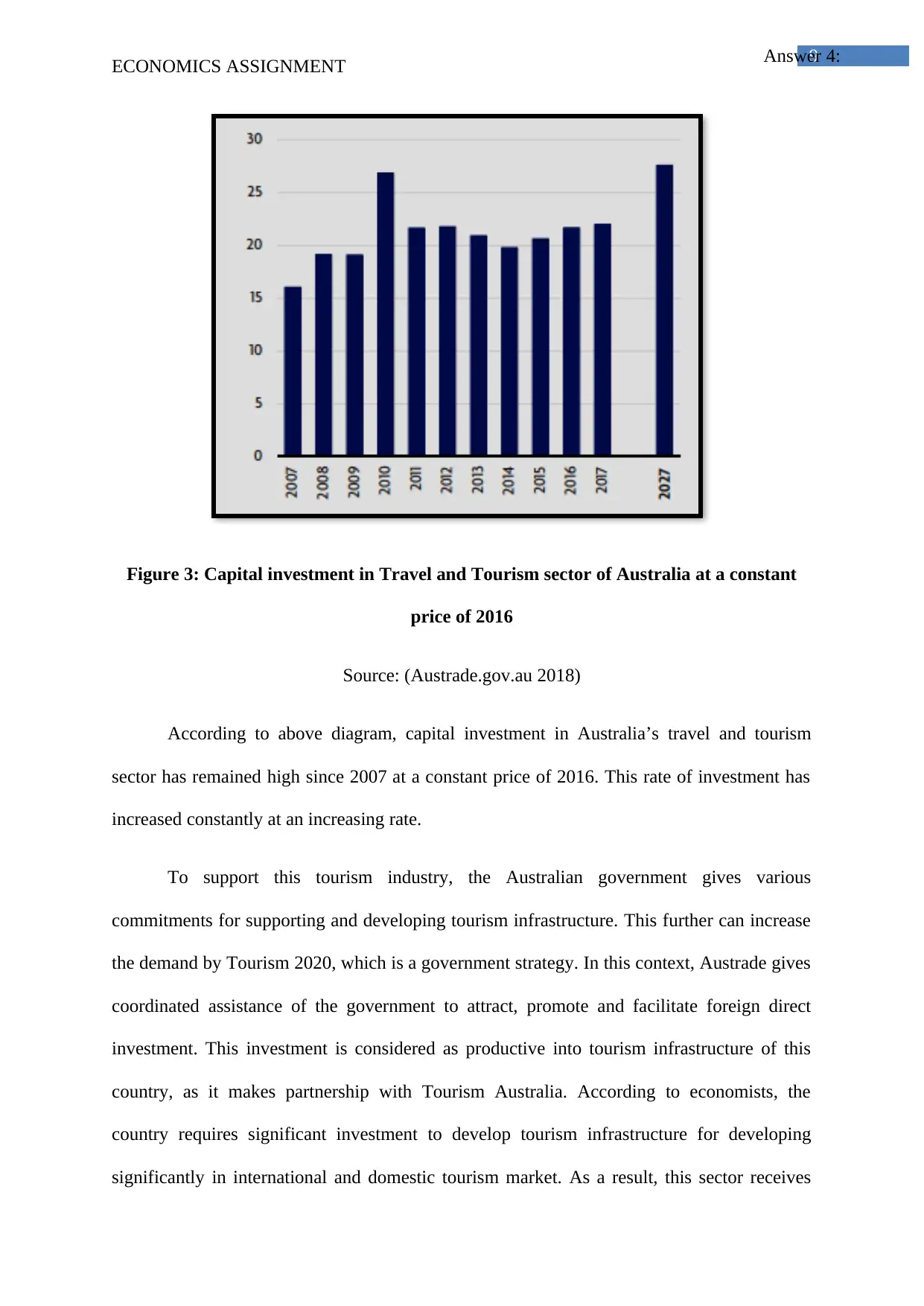
9Answer 4:
ECONOMICS ASSIGNMENT
Figure 3: Capital investment in Travel and Tourism sector of Australia at a constant
price of 2016
Source: (Austrade.gov.au 2018)
According to above diagram, capital investment in Australia’s travel and tourism
sector has remained high since 2007 at a constant price of 2016. This rate of investment has
increased constantly at an increasing rate.
To support this tourism industry, the Australian government gives various
commitments for supporting and developing tourism infrastructure. This further can increase
the demand by Tourism 2020, which is a government strategy. In this context, Austrade gives
coordinated assistance of the government to attract, promote and facilitate foreign direct
investment. This investment is considered as productive into tourism infrastructure of this
country, as it makes partnership with Tourism Australia. According to economists, the
country requires significant investment to develop tourism infrastructure for developing
significantly in international and domestic tourism market. As a result, this sector receives
ECONOMICS ASSIGNMENT
Figure 3: Capital investment in Travel and Tourism sector of Australia at a constant
price of 2016
Source: (Austrade.gov.au 2018)
According to above diagram, capital investment in Australia’s travel and tourism
sector has remained high since 2007 at a constant price of 2016. This rate of investment has
increased constantly at an increasing rate.
To support this tourism industry, the Australian government gives various
commitments for supporting and developing tourism infrastructure. This further can increase
the demand by Tourism 2020, which is a government strategy. In this context, Austrade gives
coordinated assistance of the government to attract, promote and facilitate foreign direct
investment. This investment is considered as productive into tourism infrastructure of this
country, as it makes partnership with Tourism Australia. According to economists, the
country requires significant investment to develop tourism infrastructure for developing
significantly in international and domestic tourism market. As a result, this sector receives
Paraphrase This Document
Need a fresh take? Get an instant paraphrase of this document with our AI Paraphraser
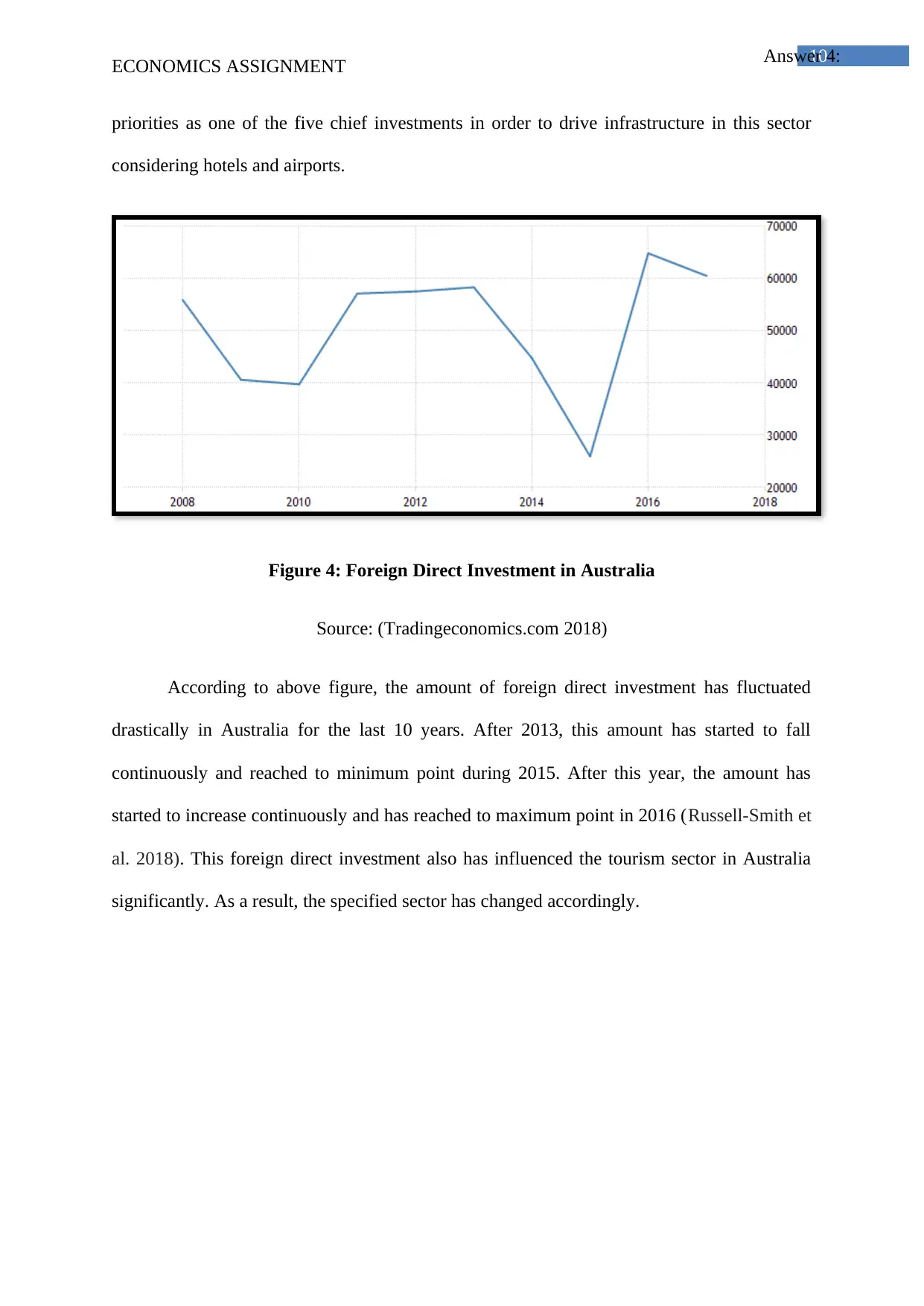
10Answer 4:
ECONOMICS ASSIGNMENT
priorities as one of the five chief investments in order to drive infrastructure in this sector
considering hotels and airports.
Figure 4: Foreign Direct Investment in Australia
Source: (Tradingeconomics.com 2018)
According to above figure, the amount of foreign direct investment has fluctuated
drastically in Australia for the last 10 years. After 2013, this amount has started to fall
continuously and reached to minimum point during 2015. After this year, the amount has
started to increase continuously and has reached to maximum point in 2016 (Russell-Smith et
al. 2018). This foreign direct investment also has influenced the tourism sector in Australia
significantly. As a result, the specified sector has changed accordingly.
ECONOMICS ASSIGNMENT
priorities as one of the five chief investments in order to drive infrastructure in this sector
considering hotels and airports.
Figure 4: Foreign Direct Investment in Australia
Source: (Tradingeconomics.com 2018)
According to above figure, the amount of foreign direct investment has fluctuated
drastically in Australia for the last 10 years. After 2013, this amount has started to fall
continuously and reached to minimum point during 2015. After this year, the amount has
started to increase continuously and has reached to maximum point in 2016 (Russell-Smith et
al. 2018). This foreign direct investment also has influenced the tourism sector in Australia
significantly. As a result, the specified sector has changed accordingly.
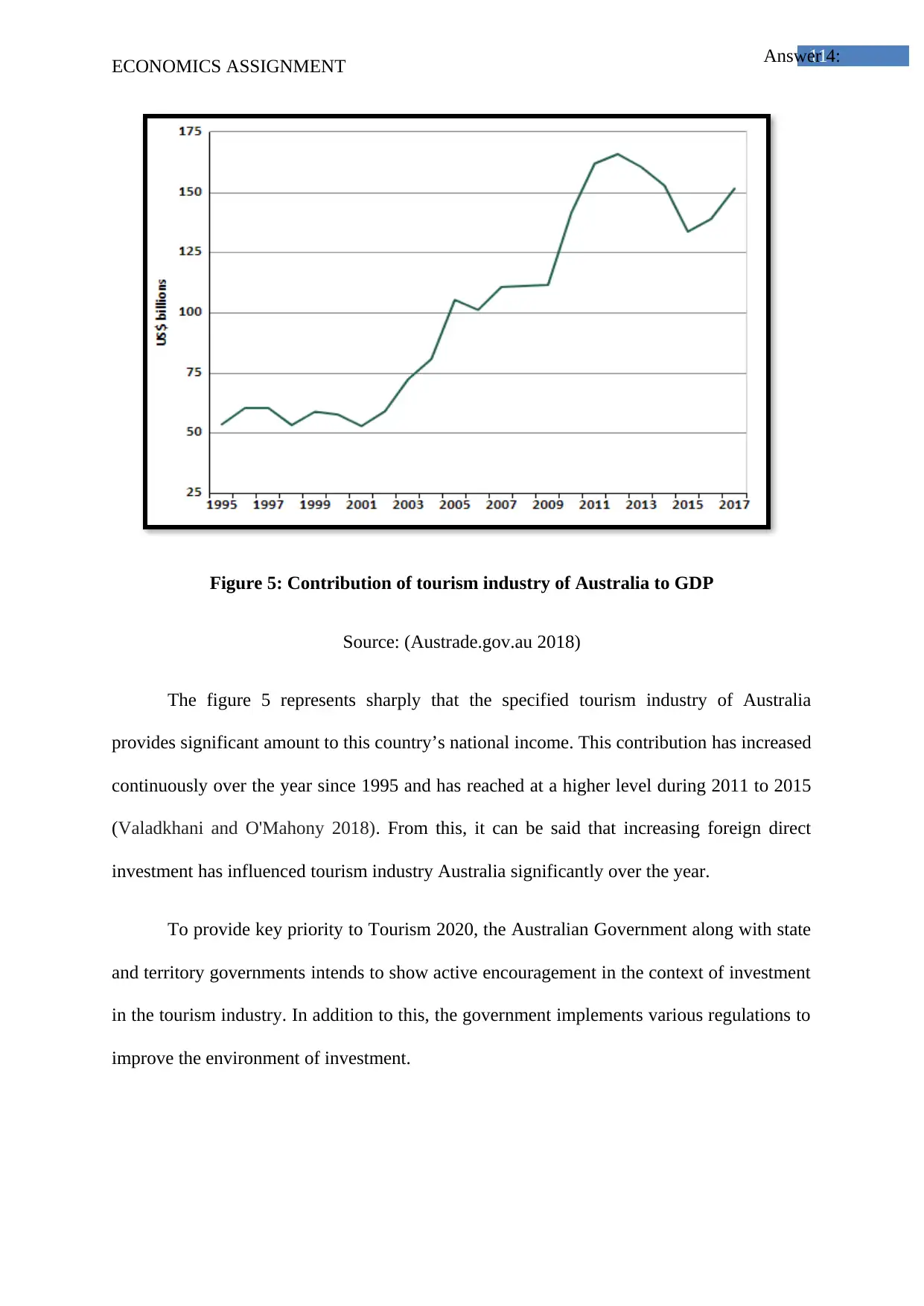
11Answer 4:
ECONOMICS ASSIGNMENT
Figure 5: Contribution of tourism industry of Australia to GDP
Source: (Austrade.gov.au 2018)
The figure 5 represents sharply that the specified tourism industry of Australia
provides significant amount to this country’s national income. This contribution has increased
continuously over the year since 1995 and has reached at a higher level during 2011 to 2015
(Valadkhani and O'Mahony 2018). From this, it can be said that increasing foreign direct
investment has influenced tourism industry Australia significantly over the year.
To provide key priority to Tourism 2020, the Australian Government along with state
and territory governments intends to show active encouragement in the context of investment
in the tourism industry. In addition to this, the government implements various regulations to
improve the environment of investment.
ECONOMICS ASSIGNMENT
Figure 5: Contribution of tourism industry of Australia to GDP
Source: (Austrade.gov.au 2018)
The figure 5 represents sharply that the specified tourism industry of Australia
provides significant amount to this country’s national income. This contribution has increased
continuously over the year since 1995 and has reached at a higher level during 2011 to 2015
(Valadkhani and O'Mahony 2018). From this, it can be said that increasing foreign direct
investment has influenced tourism industry Australia significantly over the year.
To provide key priority to Tourism 2020, the Australian Government along with state
and territory governments intends to show active encouragement in the context of investment
in the tourism industry. In addition to this, the government implements various regulations to
improve the environment of investment.
⊘ This is a preview!⊘
Do you want full access?
Subscribe today to unlock all pages.

Trusted by 1+ million students worldwide
1 out of 19
Related Documents
Your All-in-One AI-Powered Toolkit for Academic Success.
+13062052269
info@desklib.com
Available 24*7 on WhatsApp / Email
![[object Object]](/_next/static/media/star-bottom.7253800d.svg)
Unlock your academic potential
Copyright © 2020–2025 A2Z Services. All Rights Reserved. Developed and managed by ZUCOL.





